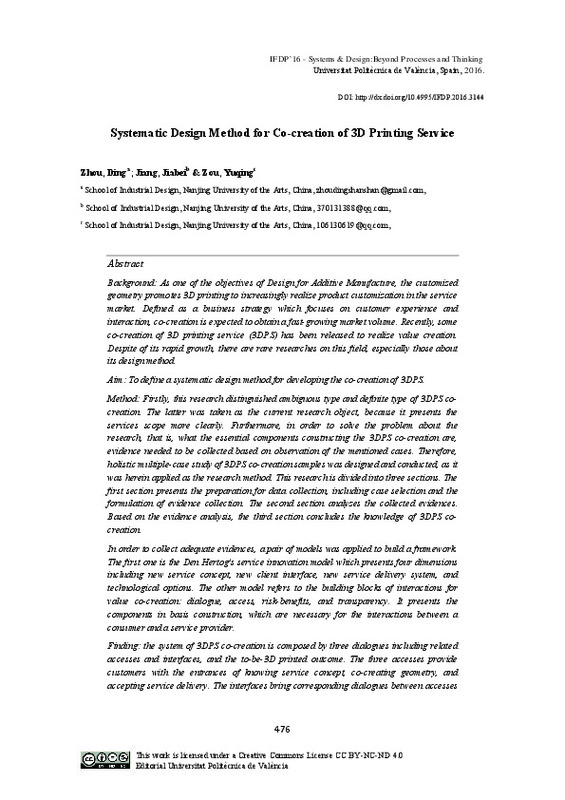|
Resumen:
|
[EN] Background: As one of the objectives of Design for Additive Manufacture, the customized
geometry promotes 3D printing to increasingly realize product customization in the service
market. Defined as a business strategy ...[+]
[EN] Background: As one of the objectives of Design for Additive Manufacture, the customized
geometry promotes 3D printing to increasingly realize product customization in the service
market. Defined as a business strategy which focuses on customer experience and
interaction, co-creation is expected to obtain a fast-growing market volume. Recently, some
co-creation of 3D printing service (3DPS) has been released to realize value creation.
Despite of its rapid growth, there are rare researches on this field, especially those about
its design method.
Aim: To define a systematic design method for developing the co-creation of 3DPS.
Method: Firstly, this research distinguished ambiguous type and definite type of 3DPS cocreation.
The latter was taken as the current research object, because it presents the
services scope more clearly. Furthermore, in order to solve the problem about the
research, that is, what the essential components constructing the 3DPS co-creation are,
evidence needed to be collected based on observation of the mentioned cases. Therefore,
holistic multiple-case study of 3DPS co-creation samples was designed and conducted, as it
was herein applied as the research method. This research is divided into three sections. The
first section presents the preparation for data collection, including case selection and the
formulation of evidence collection. The second section analyzes the collected evidences.
Based on the evidence analysis, the third section concludes the knowledge of 3DPS cocreation.
In order to collect adequate evidences, a pair of models was applied to build a framework.
The first one is the Den Hertog's service innovation model which presents four dimensions
including new service concept, new client interface, new service delivery system, and
technological options. The other model refers to the building blocks of interactions for
value co-creation: dialogue, access, risk-benefits, and transparency. It presents the
components in basis construction, which are necessary for the interactions between a
consumer and a service provider.
Finding: the system of 3DPS co-creation is composed by three dialogues including related
accesses and interfaces, and the to-be-3D printed outcome. The three accesses provide
customers with the entrances of knowing service concept, co-creating geometry, and
accepting service delivery. The interfaces bring corresponding dialogues between accesses and customer to reach each process goal. The outcome of co-creation refers to the 3D
printed artifact or 3D digital model.
Conclusion: This research proposes a four-step systemic design method for co-creation of
3DPS. Firstly, the dialogue with the interface of service concept introduction and the
access to know it is constructed. Secondly, the dialogue based on the interface of cocreation
with design variables, and the access of co-creating geometry is built. WebGL
supports its 3D graphics. Thirdly, the interface of purchasing or downloading, and the
access of accepting service delivery compose the dialogue of this step. Fourthly, the
customized artifact shall be treated by 3D printing and then delivered to customers; or a
3D digital model gets ready for downloading.
[-]
|








